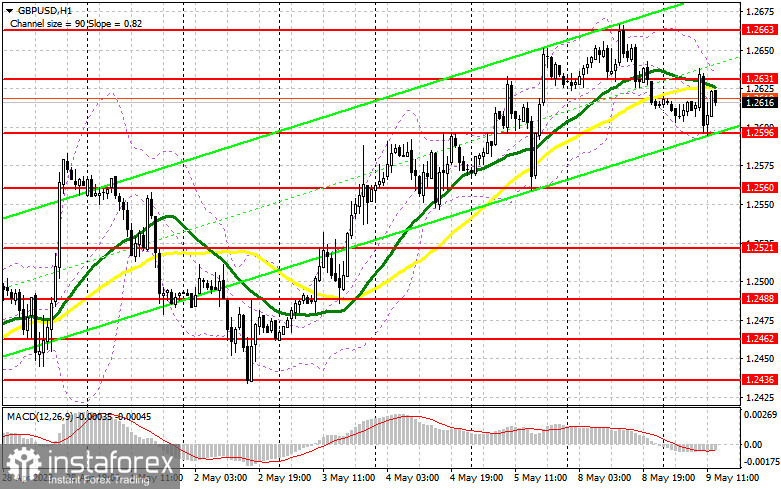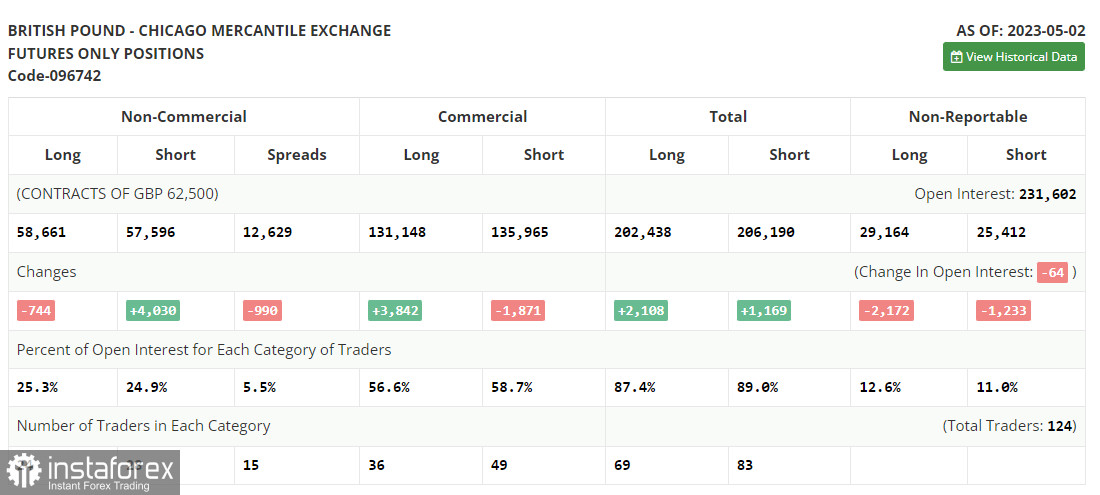In my morning forecast, I drew attention to the level of 1.2627 and recommended making decisions on entering the market from there. Let's look at the 5-minute chart and figure out what happened there. The growth and false breakout at this level allowed for an excellent entry point for short positions, eventually leading to the pair falling by more than 30 points. The technical picture has changed slightly for the day's second half.

To open long positions for GBP/USD, it is required to:
The NFIB Small Business Optimism Indicator and FOMC member John Williams' speech are all that await us in the second half of the day. Therefore, I will stick to trading within the sideways channel and try to sell the pound as high as possible. For buyers, it is best to act on the pair's decline from the nearest support of 1.2596, formed due to the first half of the day. Forming a false breakout there will allow for a buy signal with the prospect of another recovery in the area of 1.2631, which was impossible to break above in the first half of the day. Breaking and consolidating above this range will form an additional buy signal with a surge to 1.2663. The ultimate target is the area of 1.2709, where I will fix the profit.
In the scenario of a decline to the area of 1.2596 and the absence of activity from buyers in the second half of the day, which is enough for another profit-taking by large players before the Bank of England meeting, I will postpone purchases to a larger level of 1.2560. I will open long positions there only on a false breakout. I plan to immediately buy GBP/USD on the rebound from the minimum of 1.2521 to correct 30–35 points within the day.
To open short positions for GBP/USD, it is required to:
Sellers showed themselves in the first half of the day, giving an excellent entry point for selling the pound. In the case of another growth of the pair on US data, it would be nice for the bears to show themselves again in the area of 1.2631, similar to what I analyzed above. A false breakout there will give a chance to return pressure on the pound with the prospect of a decline and touching the level of 1.2596. Breaking through and retesting from below upwards in this range will increase the pressure on the pound, forming a sell signal with a fall to 1.2560. The ultimate target remains the minimum of 1.2521, where I will fix the profit.

In the case of GBP/USD growth and the absence of activity at 1.2631, which may happen since the trend remains bullish and there is still another interest rate hike by the Bank of England ahead, it is better to postpone sales until the test of the new monthly high of 1.2663. Only a false breakout there will provide an entry point for short positions. Without a downward movement, I will sell GBP/USD on the rebound immediately from the maximum of 1.2709, but only with the expectation of a pair correction down by 30–35 points within the day.
In the COT report (Commitment of Traders) for May 2, there was an increase in short positions and a decrease in long positions. Everyone understands that the Bank of England has nowhere to hide this week and will have to follow other central banks in raising interest rates. The fight against inflation in the UK will continue for quite a long time, especially considering that the regulator has not achieved any positive results in a year of rate hikes. It is unlikely that the pound will react with growth to a 0.25% rate increase, as this is already factored into the quotes, so do not be surprised if the pair demonstrates a deeper correction this week. The latest COT report states that short non-commercial positions increased by 4,030 to 57,596, while long non-commercial positions decreased by 744 to 58,661. This led to a decrease in the non-commercial net position to 1,065 against 5,839 a week earlier. This is the first decline in six weeks, so it can be considered a usual correction. The weekly price increased and amounted to 1.2481 against 1.2421.

Indicator signals:
Moving averages
Trading occurs below the 30- and 50-day moving averages, indicating the development of a bearish correction.
Note: The author considers the period and prices of moving averages on an hourly chart H1 and differs from the general definition of classical daily moving averages on a daily chart D1.
Bollinger Bands
In case of a decline, the lower border of the indicator will act as support in the region of 1.2596.
Indicator descriptions
• Moving average (determines the current trend by smoothing volatility and noise). Period 50. Marked in yellow on the chart.
• Moving average (determines the current trend by smoothing volatility and noise). Period 30. Marked in green on the chart.
• MACD Indicator (Moving Average Convergence/Divergence - convergence/divergence of moving averages) Fast EMA period 12. Slow EMA period 26. SMA period 9
• Bollinger Bands. Period 20
• Non-commercial traders - speculators, such as individual traders, hedge funds, and large institutions, using the futures market for speculative purposes and meeting certain requirements.
• Long non-commercial positions represent the total long open positions of non-commercial traders.
• Short non-commercial positions represent the total short open position of non-commercial traders.
• The total non-commercial net position is the difference between the short and long positions of non-commercial traders.
 English
English 
 Русский
Русский Bahasa Indonesia
Bahasa Indonesia Bahasa Malay
Bahasa Malay ไทย
ไทย Español
Español Deutsch
Deutsch Български
Български Français
Français Tiếng Việt
Tiếng Việt 中文
中文 বাংলা
বাংলা हिन्दी
हिन्दी Čeština
Čeština Українська
Українська Română
Română

